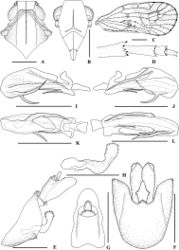Kirbyana aspina
| Notice: | This page is derived from the original publication listed below, whose author(s) should always be credited. Further contributors may edit and improve the content of this page and, consequently, need to be credited as well (see page history). Any assessment of factual correctness requires a careful review of the original article as well as of subsequent contributions.
If you are uncertain whether your planned contribution is correct or not, we suggest that you use the associated discussion page instead of editing the page directly. This page should be cited as follows (rationale):
Citation formats to copy and paste
BibTeX: @article{Zhi2021ZooKeys1037, RIS/ Endnote: TY - JOUR Wikipedia/ Citizendium: <ref name="Zhi2021ZooKeys1037">{{Citation See also the citation download page at the journal. |
Ordo: Hemiptera
Familia: Cixiidae
Genus: Kirbyana
Name
Kirbyana aspina Zhi & Chen sp. nov. – Wikispecies link – ZooBank link – Pensoft Profile
Type material
Holotype: ♂, China: Hunan Province, Wugang City, Yunshan National Forest Park (26°40'N, 110°37'E), 5 June 2011, leg. Xiang-Sheng Chen; Paratypes: 8♂♂7♀♀, same data as holotype.
Description
Body length: male 5.6‒6.1 mm (N = 9), female 5.9‒6.5 mm (N = 7).
Coloration. General color light brown (Figs 1A–E, 3J, K). Eyes blackish brown, ocelli light yellow, semitransparent. Vertex generally yellowish white. Face generally dark brown; rostrum light brown. Pronotum with discal areas and mesonotum with area between lateral carinae yellowish white, lateral areas brown. Forewing light brown, semi-translucent. Stigma light brown. The basal half dotted with small dark brown spots and distal half with two large dark brown patches; small dark brown spots on the ends of longitudinal veins. Hind tibiae and abdominal sternites yellowish brown. Head and thorax. Vertex (Figs 1C, 2A) broad, 2.2 times wider than long; anterior margin truncated, posterior margin arched and recessed. Frons (Figs 1D, 2B) widest at the level of antennae, as long as wide; frontoclypeal suture nearly concave into an arch; middle carina with basal half absent; lateral carinae distinct and slight elevated. Rostrum distinctly surpassing hind coxae, subapical segment 2.5 times longer than apical segment. Pronotum (Figs 1C, 2A) 2.4 times longer than vertex; median carina indistinct, posterior margin nearly at right angle. Mesonotum 1.7 times longer than pronotum and vertex combined. Forewing (Fig. 2C) 2.4 times longer than wide, with 10 apical and 6 subapical cells; fork Sc+RP slightly basad of fork CuA1+CuA2, first crossvein r-m at same level of fork MP, RP two branches, MP with five terminals: MP11, MP12, MP2, MP3 and MP4, fork MP1+MP2 basad of fork MP3+MP4. Metatibiotarsal formula: 6/8–9/9, second segment of hind tarsus with four platellae (Fig. 2D). Male genitalia. Pygofer (Fig. 2E, F) symmetrical, dorsal margin concave and U-shaped, slightly widened towards apex in ventral view; in lateral view, lateral lobes extended in an arc caudally, medioventral process triangular in ventral view. Anal segment (Fig. 2E, G) broad, dorsal margin almost straight, apical half of ventral margin convex, apical lobes round in lateral view; 1.7 times longer than wide in dorsal view; anal style strap-shaped, not beyond anal segment. Gonostyli (Fig. 2E, F, H) symmetrical in ventral view; in inner lateral view, base of ventral margin concave, dorsal margin bending inwards at a nearly right angle in the middle, apical part extended, apical margin round. Aedeagus (Fig. 2I–L) with total of five processes. On right side, apex of periandrium with a long spinous process, sinuous, apex directed right-dorsocephalically; basal 1/4 of ventral margin with two short spinous processes, the longer one straight, directed caudally, the shorter one slightly curved and apex directed ventrocaudally; apical 1/3 of ventral margin with a curved spinous process, apex directed apically. Endosoma moderately sclerotised, relatively short, generally curved dorsally. The left dorsal margin with a long spinous process, slightly curved, and apex directed ventrocephalically.
Female genitalia. Posterior margin of pregenital sternite concave. Tergite IX (Fig. 3A, D) moderately sclerotised, with length almost equal to width in caudal view. Anal tube (Fig. 3A, C) short, nearly rectangular, slightly widened towards apex, 1.5 times longer than wide in dorsal view; dorsal and ventral margins nearly straight in lateral view, anal styles strap-shaped. Gonapophysis VIII (Fig. 3E) elongate, and slightly curved upwards. Gonapophysis IX (Fig. 3F), distance ratio between middle tooth to apex and length of denticulate portion is 1.50. Gonoplac (Fig. 3G) rod-like, 3.7 times longer than wide. Posterior vagina (Fig. 3H, I) elongate. The ventral wall of posterior vagina with two nearly oblong sclerites basally; the dorsal wall with a small long sclerite in the middle aera.
Etymology
The specific name is derived from the Latin word “aspina”, referring to the apex of left side of periandrium without process.
Host plant
Distribution
China (Hunan).
Remarks
The male genitalia of K. aspina sp. nov. is similar to K. furcata sp. nov., but differs in: (1) endosoma with one spinous process (endosoma with three spinous processes in K. furcata); (2) base of ventral margin of the periandrium without a furcate process (base of ventral margin of periandrium with a long furcate process in K. furcata) (3) apical margin of gonostyli round in lateral view (the latter transversal).
Original Description
- Zhi, Y; Yang, L; Chen, X; 2021: Two new bamboo-feeding species of the genus Kirbyana Distant, 1906 from China (Hemiptera, Fulgoromorpha, Cixiidae) ZooKeys, 1037: 1-14. doi
Images
|


